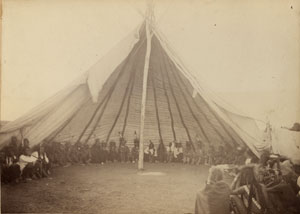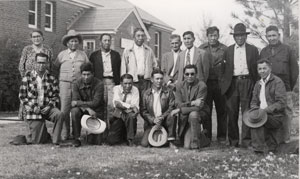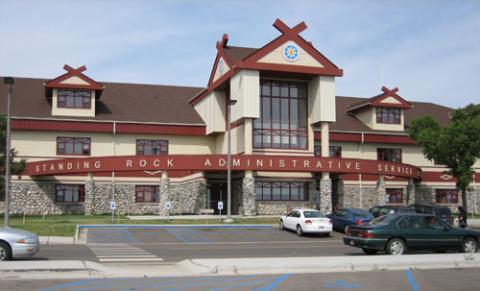Traditional Tribal Government
After permanently moving onto the Plains, the Lakota and most Dakota were nomadic hunters who traveled over vast areas of land in pursuit of the buffalo. The buffalo provided the basic needs of the people—food, hides for shelter and clothing, and bones for weapons and utensils. Dependence on the buffalo required that the people be highly mobile so most of the year they lived in small, related family groups called the tiyospaye. The tiyospaye was the basic unit of Dakota and Lakota society. Each tiyospaye, which consisted of approximately thirty households, was led by one or more headman, or leader. A headman was recognized as a leader by fully living a spiritual existence and demonstrating the values of his people—bravery, fortitude, generosity, and wisdom. Headmen sponsored ceremonies and sought to preserve the well-being of all the people. Among the Dakota and Lakota the headmen guided the people; they did not order people around. The position of a headman was not permanent. A man served at the will of the people, and if a man did not prove to be a good leader he was replaced. Decision-making was by consensus, all members of the tiyospaye contributed their input and a collective accord was reached. The process of achieving consensus insured all the people had a say in decision-making. Initially the men came together to discuss a matter; then they returned home and discussed it with their families; then at a later time the men reconvened to discuss the issue again. Although women did not customarily attend council meetings, their ideas and input were solicited and represented. This pattern would repeat until everyone was able to agree on a direction to take.

|
At least once a year the headmen from the various tiyospaye would come together to discuss issues that affected them as a whole. This level of governance, acting to promote the best interests of the various tiyospaye, was on a band level. The Hunkpapa and Sihasapa are different bands of the Lakota, and Ihanktonwana and Hunkpatina are bands of the Yanktonai. When the headmen from the various tiyospaye came together they functioned as a tribal council and were known as the Naca Omniciye. Here too the council could act only by consensus. They had a responsibility to look out for the needs of all the people and preserve the harmony of the group. Responsibilities of the Naca Omniciye were broad, and included determining and coordinating the time and place of tribal hunts and tribal moves, appointing men to assist around camp in various ways, and approving raids against enemies.
Seven to ten members of the Naca Omniciye who were thought to possess the greatest wisdom and maturity were appointed as wicasa itancan. Members of this group acted as an executive committee and were responsible for interpreting and making sure council decisions reflected the will of the people. Two to four wicasa, or “shirt wearers,” headed up this smaller council. The wicasa were highly respected and their duties involved those things that insured the well-being of all the people. Duties of wicasa ranged from reconciling quarrels between individuals or families, to negotiating with other tribes or nations.
During the summer months, the bands came together to visit and renew social bonds, conduct various spiritual ceremonies, and hunt. At these large summer encampments a national council, four men designated as wicasa yatapika led the discussions about matters that had national importance and affected all the people. Here too the decision-making was by consensus. The men designated wicasa yatapika were responsible for formulating national policy, providing guidance to the headmen and band leaders, and making sure the good of the people was preserved. They, like all leaders among the Dakota and Lakota, served at the will of the people and could be replaced if they ignored the people’s wishes. In return these leaders were highly respected by the people and their advice and council was sought out and carefully weighed before the people made decisions. (O’Brien, Sharon, 1989, pp. 23–26)
In a traditional Dakota and Lakota government group, well being was paramount to individual need, and at all levels group harmony was insured by a government run by consensus. Achieving consensus is slow and deliberate, and it insures all people are given a chance to have input and it prevents rash decisions.
Modern Government
When European nations, and later the United States, had need to conduct business with Indians they looked for a single individual or a centralized government rather than dealing with the whole tribal group. Traditional tribal governments, which operated by consensus, incorporated guards against concentration of power to preserve values of freedom, respect, and harmony. Consensus making is a slow process and simply did not fit Euro-American needs or ways of conducting business. Since the time of initial contact Europeans sought out or appointed one individual to deal with, a “chief.” Americans continued this practice in their dealings with tribes.
As relations with the tribes changed over the years, the U.S. government continued to look to ways to centralize Indian governments. In their government system, Indian people as members of a tribe attempt to meet the needs of all the people and so they seek to govern by consensus. This tension between centralizing and maintaining tribalism still exists today in relations between tribal groups and the federal government.
When Indian people were forced onto reservations, the federal government attempted to dissolve the traditional government and extinguish the languages and the spiritual beliefs and practices of the people. Still, many of the people continued conducting their own business according to more traditional patterns.
Early in the reservation era, before 1890, the Standing Rock people banded together in a council to work on issues related to the illegal seizure of the Black Hills. The Black Hills council followed a traditional pattern; it met on a local or band level; it met in various districts on the reservation, then the district representatives would come together on a reservation-wide level. At intervals representatives from the various Sioux reservations would meet as a Sioux Nation Black Hills Council. This traditional council model is still operational in the Black Hills issue today.
By 1914 the people of Standing Rock tribal took initiative and formed a tribal council. This early council had little authority in influencing the federal government but it met to discuss matters of importance among the people, to plan social events, and to represent the concerns of the Standing Rock Reservation to the federally-appointed Indian agent. This council met in local districts then came together as a whole to discuss matters. At all levels council meetings were open and input from the people was solicited.
In 1934, with the passage of the Indian Reorganization Act, the federal government sought to shift its relationship with tribes throughout the United States. By 1934 the Bureau of Indian Affairs was directing much of the day-to-day business on the reservations as well as influencing national policy in Indian Affairs. The federal government sought to get out of micro-management of reservation affairs by proposing that tribes establish constitutional forms of government and elect officials who would then govern their reservation and make some decisions that affected reservation residents on a local level. In actuality, the Bureau of Indian Affairs still maintained a strong presence on the reservations. The IRA gave the tribes greater voice in stating opinions, but it did not give them much real power. Even with the IRA, the Bureau of Indian Affairs had to approve most tribal council decisions, certify elections, and so on.
In 1934, the Indian Reorganization Act was passed by Congress and all tribes in the U.S. were encouraged to set up governments under this act. Those tribes who accepted provisions of the Indian Reorganization Act and adopted constitutions were able to borrow money from a revolving fund for consolidation of lands and economic development. Only tribes organizing under the IRA had access to this revolving loan fund. In 1934 Indian tribes, like the rest of the U.S., were in desperate depression, so the IRA with its loan fund seemed attractive. Yet many tribal groups objected to provisions that required those tribes organizing under IRA constitutions to get approval of the Secretary of the Interior in many tribal matters. The tribes objected to continued federal interference.
At Standing Rock there was much controversy over whether or not to accept the IRA—loan funds were attractive but the lack of real tribal decision-making authority was not. Although in a general election tribal members agreed to organize under the IRA, the tribal council never did write a constitution that conformed to IRA provisions. Instead, the Standing Rock Sioux Tribe continued operating under the rules of the 1914 council. In 1959 the Standing Rock Sioux re-wrote and updated the 1914 constitution and it is this document that is the basis of government on the Standing Rock Reservation today. The Standing Rock Sioux Tribe is not organized under provisions of the Indian Reorganization Act.
Currently, the Standing Rock Sioux Reservation consists of eight districts in both North Dakota and South Dakota: Fort Yates, Porcupine, Kenel, Wakpala, Little Eagle, Bear Soldier (McLaughlin), Rock Creek (Bullhead), and Cannonball. The Standing Rock Sioux Tribal Council consists of a chairman, vice chairman, secretary, and fourteen additional councilmen. The chairman, vice chairman, secretary and six of the fourteen councilmen are chosen by a reservation-wide vote. Each of the remaining eight councilmen must be residents of the district from which they are elected. All members of the Tribal Council serve four year terms.

|
The Tribal Council, as the Standing Rock Sioux Tribe’s supreme governing body is constitutionally empowered to enter into negotiations with federal, state, and local governments on the tribe’s behalf; to employ attorneys and to protect tribal land and political rights; to appoint tribal officials, boards, and organizations; to evict non-enrolled people whose presence may be detrimental to the tribe; to administer the tribal budget; to regulate property; and to pass laws and establish courts for the administration of justice. Although the Standing Rock Sioux Tribe has considerable authority, federal law mandates the Secretary of the Interior approve or disapprove certain actions by the Tribal Council.
The people of each of the eight districts on the Standing Rock Reservation comprise a local District Council which elects officers to consult, makes recommendations to and advises the tribal council, the Bureau of Indian Affairs agency superintendent, and the Secretary of the Interior, on all matters of local or tribal interest. Tribal Council members are obligated to attend local District Council meetings and report tribal business to the local people. Those council members elected by the districts must attend monthly meetings in their district; council members elected reservation-wide attend one district meeting a month. The District Councils insure input on a local level is heard.
The judicial branch of the Standing Rock Sioux Tribe is composed of a Supreme Court and Tribal Court. Initially the judges are appointed by two-thirds majority of the Tribal Council. At the time of the next general tribal election members can vote on retaining each judge. Once approved by the electorate, judges hold a four year term. The Standing Rock Sioux Tribal Court has power to hear civil, criminal, and juvenile cases.

Standing Rock Tribal Headquarters. The Standing Rock tribal headquarters building is located in Fort Yates, North Dakota.
The Standing Rock Sioux Tribe seeks to preserve its inherent tribal sovereignty and to preserve the Dakota/Lakota heritage, doing things in the best interests of all the people and representing the people’s wishes in conducting business and making decisions. The Standing Rock Sioux Tribe exerts tribal sovereignty by pursuing legislation in Congress on behalf of the tribal members, managing a variety of programs formerly run by the Bureau of Indian Affairs, establishing laws and rules of conduct on the reservation, investing tribal capital in business ventures, and so on. As the government of a tribal nation, the Standing Rock Sioux Tribal Council seeks to maintain continuity with the past and always works to preserve and encourage the best interests of all the people.